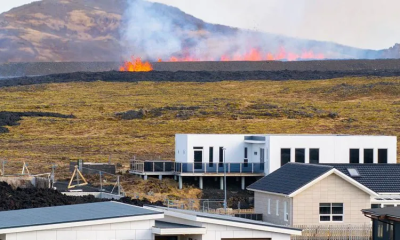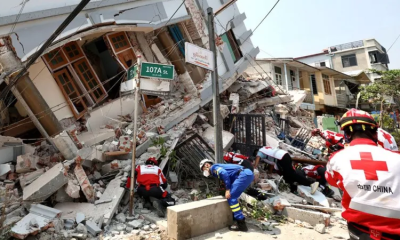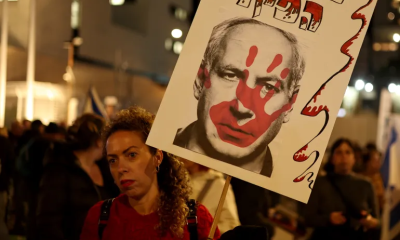Latest News
Kerr, Halliday deliver World Cup glory on dream day for New Zealad cricket

October 20 can be written in big, bold letters, as one of New Zealand cricket’s unforgettable dates. Hours after men’s team recorded a famous Test win, their first in India in 36 years, the women’s team delivered the country’s maiden T20I World Cup in style in Dubai.
As a nation of four million clocked in to work on Monday morning, Sophie Devine and Suzie Bates – “grandmas of the team” as Bates laughed in jest – had just about finished theirs, getting their hands on the Women’s T20 World Cup trophy, the cup that had agonisingly got away from them 14 years ago at Kensington Oval.
It was fitting that the two legends, who have carried the country’s cricket ecosystem for so long, through issues with depth and limited financial resources, could enjoy the night of their lives in the twilight of their storied careers.
Amelia Kerr who had hoped to dedicate the win to the golden oldies, couldn’t have stepped up with a more impactful effort – top scoring with 43, while also picking up three wickets, all with a slight limp due to cramps.
For added context, New Zealand had come into the tournament on a streak of 10 T20I losses, the longest losing streak any team has turned around to win a cricket World Cup. On this night, all of that didn’t matter though.
New Zealand came out punching knowing 134 and 141 by Australia and England respectively had been razed at this venue over the past few days. They lost Georgia Plimmer – who’d struck a couple of fours – in the second over, but Bates quickly took over. She had been striking at 90.77 in five innings coming into the final; here she showed intent right from the get go, getting a boundary – walloped over midwicket – off her second ball. But from 17 off 13, she slowed down as the introduction of spin made stroke-making a challenge.
By then, the pressure of a final had by then begun to gnaw at both teams. Marizanne Kapp missed a potential run-out opportunity against Bates in the fifth over when she couldn’t cleanly pick up a nudge at square leg. Sinalo Jafta missed a stumping opportunity in the sixth, failing to collect the ball as Bates was dragged out. It cost South Africa just 12 more though, as Bates fell for a 31-ball 32 attempting a ramp off Nonkululeko Mlaba in the eighth over.
The dismissals of Bates and Sophie Devine – due to the slowness of the surface – left New Zealand needing a massive effort from their middle order.
They went through 48 deliveries without a boundary in the middle overs. Kerr struggled, and didn’t find her hitting range until the last few deliveries of her 38-ball vigil that brought 43. It wasn’t until the arrival of Brooke Halliday the left-hander, did New Zealand break out of a rut.
Halliday brought out a slog sweep in the 14th off Sune Luus to break the boundary drought, and once the shackles were broken, New Zealand had another boundary off the very next ball. By jumping around the crease and opening scoring areas behind square on the leg side through sweeps and slogs, Halliday’s presence breathed life into an innings that had been struggling to get out of second gear.
Halliday’s enterprise helped raise a half-century stand off just 37 balls with Kerr playing a support role. Halliday’s highest in T20Is, in 32 previous innings, had been 33 while striking at 82. Here, under the pressure of a final, Halliday’s career-best 38 had come of 28.
A cameo from Maddy Green provided New Zealand a late lift: 48 off the last five, as they finished with 158, two less than the score they comfortably defended against India in their tournament opener.
New Zealand took a cue from their batting innings and introduced spin in the second over with Eden Carson and Fran Jonas trying to apply the squeeze. For the first three overs, South Africa managed just two boundaries, but kept hitting the ball into gaps to keep up with the asking rate.
In last year’s final, Laura Wolvaardt held the chase together, trying to get into a position from where she could tee off amid a collapse. Here, she decided to punch away as the enforcer, picking lengths early and pummelling with her strong forearms, showing a side of her game that is in stark opposition to her artistry.
With Tazmin Brits solid, it was the first time in the tournament that New Zealand failed to pick up a wicket in the powerplay. At 47 for 0, South Africa were on course.
Jonas broke through to dismiss Brits in the seventh, but it was Wolvaardt’s dismissal, attempting to hit Kerr inside-out only to find Bates at extra cover, that had a deflating effect on South Africa. That was Bates’ first of three catches in the innings. Five balls later, Kerr had her second when Anneke Bosch, who had knocked Australia out two nights ago with a sensational 74, tickled an attempted sweep to Izzy Gaze. Originally unsure if there was an edge, Kerr convinced Devine to review and was proven correct.
Carson then dealt the blow that arguably ended South Africa’s hopes when she had Kapp mistiming a slog to deep midwicket in the 12th over. Kapp’s agonising walk back and Kerr’s ecstasy provided two contrasting emotions in one frame. A telling picture of who would have their hands on the trophy before the night was out.
Brief scores:
New Zealand Women 158 for 5 in 20 overs (Amelia Kerr 43, Brooke Halliday 38, Suzie Bates 32; Ayabonga Khaka 1-44, Chloe Tryon 1-22, Nonkululeko Mlaba 2-31, Nadine Klerk 1-17) beat South Africa Women 126 for 9 in 20 overs (Laura Wolvaardt 33; Rosemary Mair 3-25, Amelia Kerr 3-24, Eden Carson 1-22, Fran Jonas 1-28, Brooke Halliday 1-04) by 32 runs
[Cricinfo]
Latest News
Tourists and residents evacuated as volcano erupts in Iceland
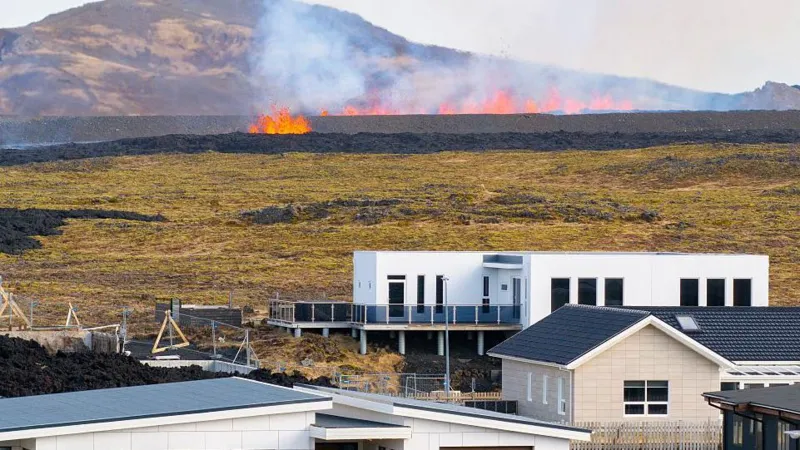
Tourists and residents have been evacuated as a volcano erupted in south-west Iceland, threatening a town and popular attraction.
The volcano has been spewing lava and smoke in a fiery display of orange and red since the eruption began in the morning, creating a huge crack in the ground which has grown to 1.2km (0.75 miles) long.
Multiple earthquakes have occurred in the volcanic area throughout the day.
The volcano is close to the fishing town of Grindavik and the famous Blue Lagoon spa. A small number of people refused to evacuate the town, local media reported.
People were asked to “leave the danger zone,” the region’s police commissioner, Ulfar Ludviksson, told Iceland’s RUV broadcaster. But he said individuals staying in “seven or eight houses there… have decided to remain in the town.”
There were fears that the town was “in danger of having lava flows entering the inhabited area”, said Rikke Pedersen from the Nordic Volcanological Centre.
A hot water pipe has broken in the northern part of Grindavík, which confirms that considerable cracking has occurred within the town, the Icelandic Meteorological Office (IMO) said.
The protective barriers around Grindavik have also been breached, as new eruptive fissure opened a few hundred meters inside, the IMO reported. But volcanic activity eased off in the early afternoon on Tuesday.
Roads in and out of the town remain closed, but flights are currently not affected.
Most of the 4,000 residents of Grindavík left in a mass evacuation in 2023 because of the dangers of the volcanic activity. The volcano has erupted several times since.
The length of the magma that formed on Tuesday under the crater series stretched to about 11 km (6.8 miles) – the longest that has been measured since 11 November 2023, meteorologists said. The magma corridor extends about 3km further northeast than seen in previous eruptions.
Based on current wind direction, gas pollution from the eruption will travel northeast towards the capital area, the IMO added.
The eruption, which began around 09.45 local time (10:45 BST), occurred after several earthquakes hit the area known as the Sundhnúk crater range.
Multiple eruptions have occurred on the Reykjanes Peninsula since 2021. The last time the peninsula had a period of volcanic activity was 800 years ago – and the eruptions continued for decades.
Iceland has 33 active volcano systems and sits over what is known as the Mid-Atlantic Ridge, the boundary between two of the largest tectonic plates on the planet.
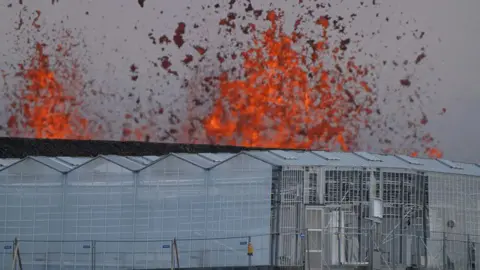
[BBC]
Latest News
Mandalay was the ‘city of gold’ – now it reeks of death
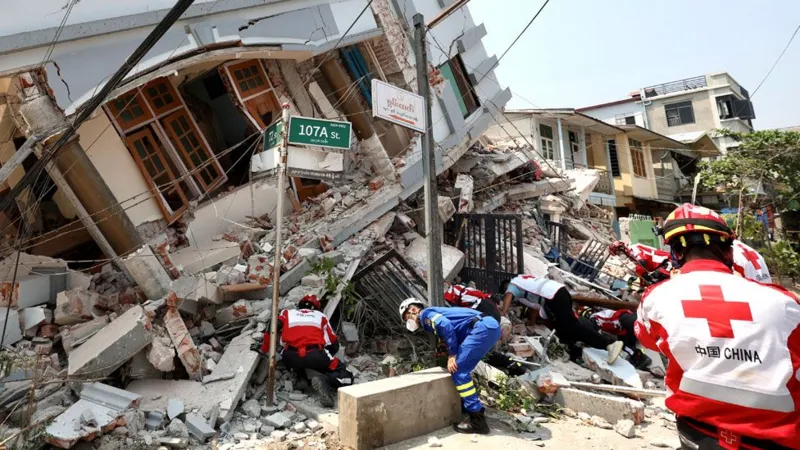
Mandalay used to be known as the city of gold, dotted by glittering pagodas and Buddhist burial mounds, but the air in Myanmar’s former royal capital now reeks of dead bodies.
So many corpses have piled up since a 7.7 magnitude earthquake struck last Friday close to Mandalay, that they have had to be “cremated in stacks”, one resident says.
The death toll from the quake and a series of aftershocks has climbed past 2,700, with 4,521 injured and hundreds still missing, Myanmar’s military chief said. Those figures are expected to rise.
Residents in the country’s second most populous city say they have spent sleepless nights wandering the streets in despair as food and water supplies dwindle.
The Mandalay resident who spoke of bodies being “cremated in stacks” lost her aunt in the quake.
“But her body was only pulled out of the rubble two days later, on 30 March,” said the 23-year-old student who wanted only to be known as J.
Poor infrastructure and a patchwork of civil conflicts are severely hampering the relief effort in Myanmar, where the military has a history of suppressing the scale of national disasters. The death toll is expected to keep rising as rescuers gain access to more collapsed buildings and cut-off districts.
J, who lives in Mandalay’s Mahaaungmyay district, has felt “dizzy from being deprived of sleep”, she said.
Many residents have been living out of tents – or nothing – along the streets, fearing that what’s left of their homes will not hold up against the aftershocks.
“I have seen many people, myself included, crouching over and crying out loud on the streets,” J said.
But survivors are still being found in the city. The fire service said it had rescued 403 people in Mandalay in the past four days, and recovered 259 bodies. The true number of casualties is thought to be much higher than the official version.
In a televised speech on Tuesday, military chief Min Aung Hlaing said the death toll may exceed 3,000, but the US Geological Survey said on Friday “a death toll over 10,000 is a strong possibility” based on the location and size of the quake.
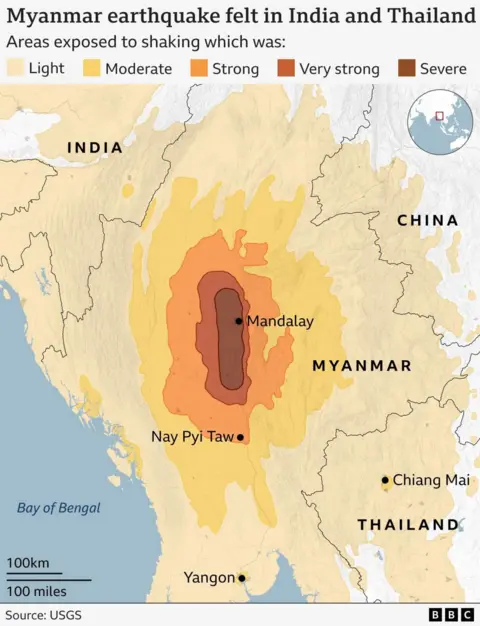
Young children have been especially traumatised in the disaster.
A local pastor told the BBC his eight-year-old son had burst into tears all of a sudden several times in the last few days, after witnessing parts of his neighbourhood buried under rubble in an instant. “He was in the bedroom upstairs when the earthquake struck, and my wife was attending to his younger sister, so some debris had fallen onto him,” says Ruate, who only gave his first name. “Yesterday we saw bodies being brought out of collapsed buildings in our neighbourhood,” said Ruate, who lives in the Pyigyitagon area.
“It’s very sobering. Myanmar has been hit by so many disasters, some natural, some human made. Everyone’s just gotten so tired. We are feeling hopeless and helpless.”
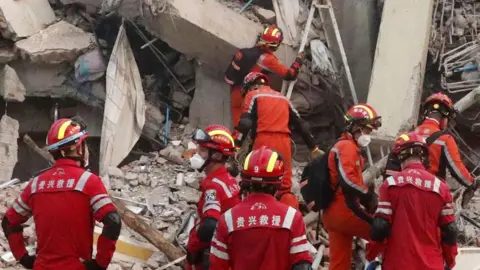
A monk who lives near the Sky Villa condominium, one of the worst-hit buildings reduced from 12 to six storeys by the earthquake, told the BBC that while some people had been pulled out alive, “only dead bodies have been recovered” in the past 24 hours. “I hope this will be over soon. There are many bodies still inside, I think more than a hundred,” he said.
Crematoriums close to Mandalay have been overwhelmed, while authorities have been running out of body bags, among other supplies, including food and drinking water.
Around the city, the remains of crushed pagodas and golden spires line the streets. While Mandalay used to be a major centre for the production of gold leaf and a popular tourist destination, poverty in the city has soared in recent years, as with elsewhere in Myanmar (formerly called Burma).
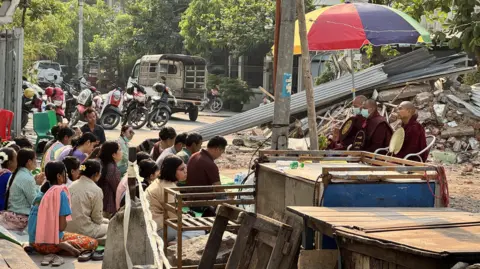 BBC Burmese
BBC BurmeseLast week’s earthquake also affected Thailand and China, but itsnimpact has been especially devastating in Myanmar, which has been ravaged by a bloody civil war, a crippled economy and widespread disillusionment since the military took power in a coup in 2021.
On Tuesday, Myanmar held a minute of silence to remember victims, part of a week of national mourning. The junta called for flags to fly at half mast, media broadcasts to be halted and asked people to pay their respects.
Even before the quake, more than 3.5 million people had been displaced within the country.
Thousands more, nany of them young people, have fled abroad to avoid forced conscription – this means there are fewer people to help with relief work, and the subsequent rebuilding of the country.
Russia and China, which have helped prop up Myanmar’s military regime, are among countries that have sent aid and specialist support.
But relief has been slow, J said.
“The rescue teams have been working non-stop for four days and I think they are a little tired. They need some rest as well.
“But because the damage has been so extensive, we have limited resources here, it is simply hard for the relief workers to manage such massive destruction efficiently,” she said.
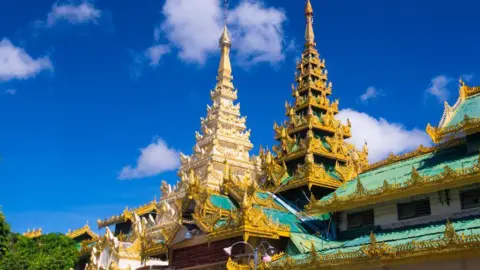
While the junta had said that all assistance is welcome, some humanitarian workers have reported challenges accessing quake-stricken areas.
Local media in Sagaing, the earthquake’s epicentre, have reported restrictions imposed by military authorities that require organisations to submit lists of volunteers and items that they want to bring into the area.
Several rights groups, including Human Rights Watch and Amnesty International, have urged the junta to allow aid workers immediate access to these areas.
“Myanmar’s military junta still invokes fear, even in the wake of a horrific natural disaster that killed and injured thousands,” said Bryony Lau, Human Rights Watch’s deputy Asia director.
“The junta needs to break from its appalling past practice and ensure that humanitarian aid quickly reaches those whose lives are at risk in earthquake-affected areas,” she said.
The junta has also drawn criticism for continuing to open fire on villages even as the country reels from the disaster.
[BBC]
Latest News
PM visits France to attend high-level conference at UNESCO

The Prime Minister of Sri Lanka Dr. Harini Amarasuriya is on an official visit to Paris, France to participate in the high-level segment of the International Expert Conference on ’An Integrated and Sustainable Approach to Safeguarding the World Heritage Property of the Sacred City of Anuradhapura in Sri Lanka and Associated Living Heritage’ which was to be held at UNESCO Headquarters today [Tuesday 1 April], with the participation of the Director-General of UNESCO Audrey Azoulay.
The Conference, organized by UNESCO in partnership with Sri Lanka, brings together leading international experts to discuss sustainable strategies for the conservation of Anuradhapura, a UNESCO World Heritage Site of immense cultural and historical significance.
On the sidelines of the Conference, the Prime Minister is also scheduled to meet senior interlocutors of the French Government to discuss bilateral cooperation and areas of mutual interest.
The Delegation of the Prime Minister includes the Minister of Buddhasasana Religious and Cultural Affairs, Dr. Hiniduma Sunil Senevi.
[Prime Minister’s Media Division]
-

 Sports3 days ago
Sports3 days agoSri Lanka’s eternal search for the elusive all-rounder
-

 Features7 days ago
Features7 days agoCelebrating 25 Years of Excellence: The Silver Jubilee of SLIIT – PART I
-

 News4 days ago
News4 days agoGnanasara Thera urged to reveal masterminds behind Easter Sunday terror attacks
-

 Business7 days ago
Business7 days agoCEB calls for proposals to develop two 50MW wind farm facilities in Mullikulam
-

 Business5 days ago
Business5 days agoAIA Higher Education Scholarships Programme celebrating 30-year journey
-

 Features7 days ago
Features7 days agoNotes from AKD’s Textbook
-

 News2 days ago
News2 days agoBid to include genocide allegation against Sri Lanka in Canada’s school curriculum thwarted
-

 News3 days ago
News3 days agoComBank crowned Global Finance Best SME Bank in Sri Lanka for 3rd successive year


